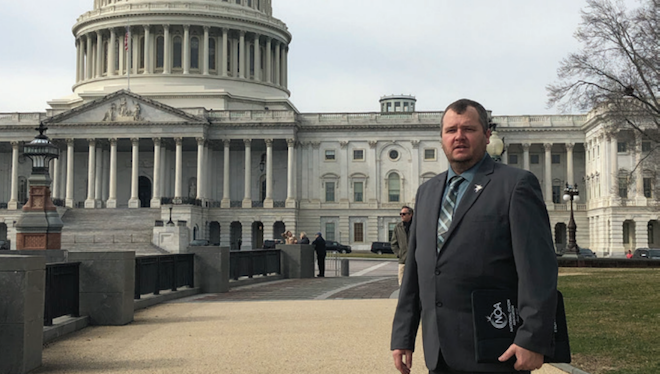

Apr 3, 2020National Onion Association president lobbies for change
Increased participation and advocacy are goals for the National Onion Association’s (NOA) new president.
Trustees of the group, which includes more than 500 growers, shippers, packers and suppliers of bulbs, recently elected Wisconsin’s Doug Bulgrin president. He’ll lead the organization for two years.
He grew up on a dairy farm in the central Wisconsin town of Portage, but for the nearly 30 years, he has worked in specialty crops – first for the Lewiston Corp. When Gumz Farms bought out Lewiston in 1997, “You might say I came on as part of the deal,” Bulgrin said.
Currently, he’s the onion packing shed manager for Gumz, which grows 750 acres of yellow onions in addition to about a thousand acres of red potatoes, some mint, corn and soybeans. The mint is distilled on the farm and the potatoes and onions are “consumer-packed” for retail sales. Doug’s brother Tom manages the potato packaging.
The NOA holds its summer and winter meetings in different areas each year so the growers can visit a variety of operations. Bulgrin, who became involved in the organization a few years ago to work on food and safety issues, has been impressed with how differently onions are grown across the country. Although most onions are grown in the Northwest, especially Washington and Oregon, before being shipped East, other main growing regions include New York, Michigan, Wisconsin, the South and its sweet onions including Georgia Vidalias, North Dakota and the Southwest coast reaching into Mexico.
“In traveling around to the different growing regions, it’s kind of interesting because each region has its different challenges that they deal with when they try to grow onions,” Bulgrin said. “Environments are so different. Some of the South and West states are trying to get enough water to produce a crop and they’re worried about how much runoff they can capture. Here in the Midwest, and to the East, it’s kind of the opposite. We’re worried about how we can pump water off or keep the fields well-drained. Then in turn with our lush vegetation around the fields, we have more issues in terms of trying to handle pests … weeds are more easily transferred into the field.” Some areas in the South still can find enough labor for hand harvests, while in the Northeast and Midwest most onions are harvested by machine.
Recent years have also seen the introduction of many new sweet onion varieties, including Sunions, Honeysweet, Sun Kissed in addition to classics like Vidalia – similar to the diversification of varieties that the apple industry has seen.


“Everybody wants to have their own special onion and make that special place in the market for themselves,” Bulgrin said. “There’s some of the onions I definitely see some advantages, one over the other as far as storability and different things. It comes down to personal taste – that’s why there so many different cars sold in the U.S. whether its Ford or Chevy or Dodge. Everybody has their own idea of what they’re looking for.”
Despite very different growing conditions and diversification, the growers have common interests and there are many reasons they join the NOA, Bulgrin said.
“We do struggle with some of the same things when it comes to laws and regulations, whether it be food safety or labor,” he said. “And some of the pests we deal with are quite similar.” The group also sponsors some research about water quality methods, and watches that imports are held accountable to the same standards as domestic onions.
Bulgrin said probably the key task the association can do is band together for advocacy efforts.
“Were actually fighting for the ability of the farmer to still maintain doing what he’s doing,” he said. Too much of the population is fa rremoved from agriculture and don’t understand farmers or farming.
“People need to understand, farmers are good people and we are taking care of the environment,” Bulgrin said. He and his wife have spent the last seven years farming with their children to introduce them to agriculture. They farm corn, soybeans and pumpkins together.
Bulgrin attended his first Washington D.C. trip with the NOA leadership last year. The trip made a deep impression on him – he didn’t think one person could make a difference, but he was impressed at how the officials seemed open to hearing from him, and respected his expertise.
“These are highly intelligent people who are making some big decisions for our country, and they’re looking for input from us – the guys out there in the field,” he said. “It really takes all of us working together to keep moving forward and working on these issues, but understanding the effects they’re having on the farmer.
Bulgrin has a particular interest in food safety and consolidating food safety inspections and audits.
“It wasn’t too long ago that I had five audits that I was doing,” each for a different customer, he said. Implementation of the Food and Safety Modernization Act can be hard on many farmers – as Bulgrin said, “We have a job to do besides doing audits.”
He was able to communicate some of that with officials in Washington, and he hopes other onion growers can get involved in similar ways.
“There’s a lot of talented people in NOA, and my dream is to just draw off of that membership and that knowledge,” he said. “The more effort that people put into it, the more that they’re going to reap the benefits.”
— Stephen Kloosterman, associate editor














